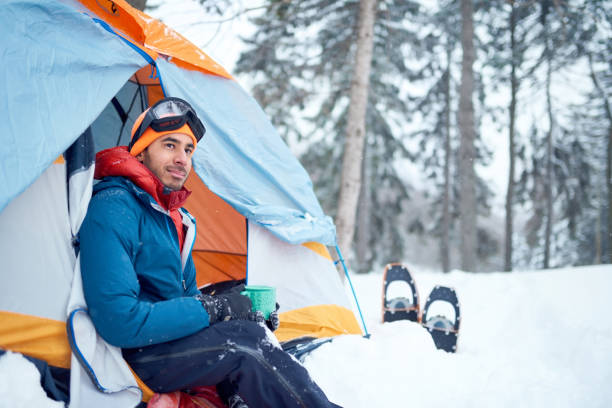Winter camping isn’t for the faint of heart. But for those who crave the thrill of adventure amidst a frosted wonderland, it’s an experience unlike any other. That said, if you truly want to conquer the cold, you will need much more than just a brave spirit. You’ll need the right rooftop tent.
This guide is your cheat sheet for conquering the cold. We’ll break down the must-have features for a winter-worthy tent, compare the different chill-chasing models, and toss some gear tips for ultimate snuggle time.
Let’s get into it.
Essential Features for a Winter Rooftop Tent
When battling blizzardy nights and frosty mornings, your rooftop tent becomes your fortress of comfort. Picking the right one means staying toasty and adventurous all winter long. Here’s what to prioritize:
Thick Insulation: 4-season tents boast beefed-up insulation, often using multi-layer walls and roofs with materials like closed-cell foam or quilted fabric. This creates a cozy barrier against the biting cold, making your tent feel like a snug cocoon. Imagine waking up to snowy landscapes without a chattering jaw!
Weatherproof Warriors: Winter throws everything at you – wind, snow, rain. Your tent needs to be ready. Look for a durable, waterproof fabric like ripstop polyester or canvas with a high hydrostatic head (HH) rating, indicating its ability to withstand water pressure. A storm-proof rainfly adds another layer of protection against the elements.
Snow Skirts and Ventilation: Snow isn’t your friend when it comes to warmth. Choose a tent with generous snow skirts that attach to your vehicle, preventing sneaky drafts and pesky snowdrifts from invading your cozy haven. Proper ventilation is crucial too. Look for vents that allow moisture to escape and prevent condensation buildup, keeping your tent dry and breathable.
Comfy Floor and Room to Breathe: Winter means layers, lots of them. Make sure your tent has a comfortable floor that insulates you from the cold metal roof. Some even have built-in mattresses or insulated flooring. And don’t skimp on space! Choose a tent with enough headroom and floor area to let you stretch out, change clothes, and even share the warmth with a furry friend.
Bonus Features: Think about extras that’ll make your winter camping even more enjoyable. A built-in awning provides shelter from the elements while setting up camp. Rooftop hammocks offer stunning stargazing opportunities. And let’s not forget pre-wired electrical hookups for powering lights or a small heater for extra warmth on those extra-chilly nights.
Comparing Different Rooftop Tent Types for Winter
Now that you know the essential features, let’s explore the main types of rooftop tents and how they stack up in winter conditions:
Hard-Shell Tents: These sturdy beasts resemble miniature campers, offering excellent insulation and wind resistance. Their pre-assembled design makes setup a breeze, even in the coldest weather. However, their weight and bulk can be a challenge for smaller vehicles and require extra roof strength.
Soft-Shell Tents: Lighter and more compact than their hard-shell counterparts, soft-shell tents are easier to store and transport. They’re generally more affordable, too. However, their insulation may not be as efficient, and they can be more susceptible to wind and snow.
Hybrid Tents: Combining the advantages of both worlds, hybrid tents offer a lightweight, aerodynamic design with decent insulation. Their pop-up or manual setup is quicker than most hard-shell tents, making them a good compromise for winter adventurers.
Ultimately, the best type for you depends on your priorities. Consider your budget, vehicle capabilities, camping style, and desired level of comfort. Do you value ultimate warmth and convenience? A hard-shell might be your champion. Prioritize portability and affordability? A soft-shell could be your perfect match. Seeking a balance of features? A hybrid might be the sweet spot.
Essential Winter Camping Gear for Your Rooftop Tent
Your rooftop tent is the fortress, but it’s the gear that makes it a haven. Here are some must-haves for your winter camping arsenal:
Warm Sleeping Sanctuary: Invest in a high-quality, winter-specific sleeping bag with a temperature rating that matches your anticipated camping conditions. Don’t skimp! A poorly rated bag can turn your cozy tent into a shivering nightmare. A thick, insulated sleeping pad adds another layer of warmth between you and the cold metal floor.
Layered Up Comfort: Forget cotton! Pack moisture-wicking base layers, warm fleece or wool mid-layers, and a waterproof outer shell to stay dry and comfortable. Extra socks, gloves, and a beanie are essential for keeping extremities toasty. Consider down booties or heated socks for extra foot warmth.
Fueling Your Winter Adventures: A reliable camp stove is key for cooking hot meals and melting snow for water. Choose one that performs well in cold temperatures and consider fuel options like propane canisters or refillable tanks. Don’t forget a mess kit, utensils, and a lighter or matches.
Shining a Light on the Cold: Winter nights are long and dark. Pack a headlamp for hands-free light and a lantern for illuminating your tent and campsite. Extra batteries and a solar charger are lifesavers if your power source runs out.
Safety First: Pack a first-aid kit, emergency blanket, and fire starter. Remember, winter camping requires preparedness. Consider a satellite communicator or personal locator beacon for remote adventures.
Tools for the Job: A compact shovel is essential for clearing snow around your tent. Traction mats or snow chains for your vehicle can be lifesavers on slippery roads. Don’t forget a headlamp for nighttime adjustments.
Conclusion
So, there you have it! From choosing the perfect fortress to packing your winter essentials, you’re now equipped to conquer the frosty landscapes. Remember, winter camping is about embracing the challenge, savoring the solitude, and waking up to breathtaking sunrises.
Don’t let the cold hold you back! Head over to Roof Top Tents and explore their incredible selection of winter-ready tents and gear.


